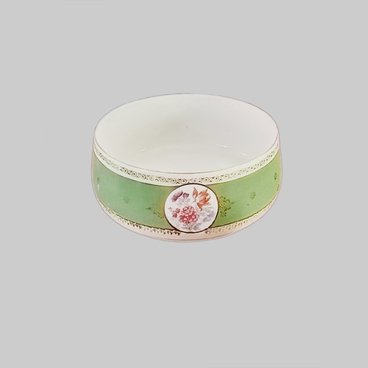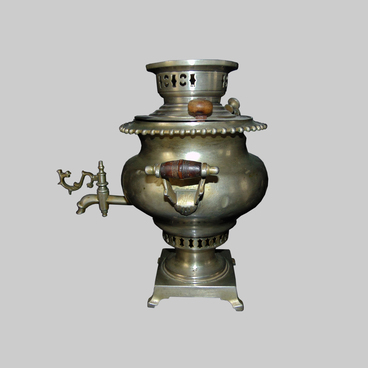The decorative and applied art in Russia is largely defined by The Partnership of Porcelain and Faience Manufacture of M.S. Kuznetsov. By the end of the 19th century it had united the oldest and largest domestic enterprises engaged in the production of porcelain and faience: Dulevo porcelain factory, Gardner porcelain factory, Budy faience factory and many others. Kuznetsov’s Partnership not only made porcelain tableware more accessible to the public, but also brought Russian porcelain to the international market.
Products manufactured by the Partnership, often referred to as Kuznetsov porcelain, were also widely popular among Russian nobles. In the large sitting room there is a delicate light green porcelain set, made in the early 20th century. That set can justly be defined by the tea cup and saucer alone, as the milk jug or the candy bowl were used less often and served as complementary items for formal tea parties with guests. The image of a flower painted on the saucer rhymes beautifully with the patterns on the tea cup, which has a floral composition depicted on one of its sides. Another unique feature of the set’s design is the darkened edges on the saucer and a lighter shade in its center, visually giving the tea cup placed on it much more room.
Even though entrepreneur Matvey Sidorovich Kuznetsov has managed to build a porcelain empire, and his grandfather Yakov Kuznetsov founded the family business, no less remarkable was the figure of Terenty Kuznetsov. It was he who established the Dulevo porcelain factory in Vladimir province (now located in the Moscow Region). Subsequently, the products of this factory became famous throughout the Russian Empire and were named Dulevo porcelain. Moreover, the company survived the Soviet regime, the war, the collapse of the USSR and continues to operate even to this day.
Later, Dulevo porcelain factory became one of the main enterprises of the Kuznetsov Partnership. By the end of the 19th century, Kuznetsov porcelain had become as common and popular as, for example, Vologda butter. In the early 20th century, the Partnership was honored one of the most honorary titles of Russian trademarks: the Supplier of the Court of His Imperial Majesty. At that time, this title was held by no more than 30 to 40 companies, which also included several European manufacturers.
Products manufactured by the Partnership, often referred to as Kuznetsov porcelain, were also widely popular among Russian nobles. In the large sitting room there is a delicate light green porcelain set, made in the early 20th century. That set can justly be defined by the tea cup and saucer alone, as the milk jug or the candy bowl were used less often and served as complementary items for formal tea parties with guests. The image of a flower painted on the saucer rhymes beautifully with the patterns on the tea cup, which has a floral composition depicted on one of its sides. Another unique feature of the set’s design is the darkened edges on the saucer and a lighter shade in its center, visually giving the tea cup placed on it much more room.
Even though entrepreneur Matvey Sidorovich Kuznetsov has managed to build a porcelain empire, and his grandfather Yakov Kuznetsov founded the family business, no less remarkable was the figure of Terenty Kuznetsov. It was he who established the Dulevo porcelain factory in Vladimir province (now located in the Moscow Region). Subsequently, the products of this factory became famous throughout the Russian Empire and were named Dulevo porcelain. Moreover, the company survived the Soviet regime, the war, the collapse of the USSR and continues to operate even to this day.
Later, Dulevo porcelain factory became one of the main enterprises of the Kuznetsov Partnership. By the end of the 19th century, Kuznetsov porcelain had become as common and popular as, for example, Vologda butter. In the early 20th century, the Partnership was honored one of the most honorary titles of Russian trademarks: the Supplier of the Court of His Imperial Majesty. At that time, this title was held by no more than 30 to 40 companies, which also included several European manufacturers.



